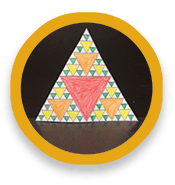SCIENCE EXPERIMENTS FOR KIDS
LEARNING ABOUT SIERPINSKI TRIANGLES
If your child thinks the only famous triangle is in Bermuda, this project is for them
Sierpinski triangles are perfectly self-similar fractals. Your budding scientist will learn about them and make their own Sierpinski triangle fractal in this simple project that teaches about shapes, geometry and structural engineering.
Using the template provided, your child will color and then cut out their own triangles and then scale up the Sierpinski triangle fractal to create a larger one. They can rest assured that no airplanes have ever disappeared in the Sierpinski triangle.
GATHER THIS:
- Paper
- Coloring tool, pencils, crayons, etc.
- Optional: scissors, tape
THEN DO THIS:
- Color the Sierpinski triangle below.
- Print or draw many equilateral triangles and tape them together on a wall to scale up the Sierpinski triangle fractal. Ask family and friends to help!
- Challenge: Make a 3-Dimensional Sierpinski triangle pyramid!
ASK THIS:
- Can you continue scaling down the pattern smaller than the template provides? Where do the next colored triangles go?
- Are there other shapes that can make self-similar repeating patterns?
- Where do you see fractals in nature?
- Look up a Von Koch snowflake!
WHAT IS HAPPENING?
A Sierpinski triangle is a self-similar fractal described by Waclaw Sierpinski in 1915. Self-similar means when you zoom in on a part of the pattern, you get a perfectly identical copy of the original. A fractal is a quantitative way to describe and model roughness. In this case, we mean the roughness of the perimeter of the shape. Most fractals are not self-similar and can be found in nature. Examples of fractals in nature are the branching patterns of tree branches, lightning, shells, ocean waves, and river systems.
Benoit Mandelbrot, the father of fractal geometry was inspired to create a formula for describing the roughness of an outline, such as the coastline of Britain, for pragmatic purposes. The formula for roughness of the perimeter of the shapes is quantifiable and is used to model soil erosion design more compact and efficient antenna.
WHAT THIS TEACHES:
Skills: Shapes, patterns, fractals, observation skills
Themes: Shapes, geometry, structural engineering
Join the CuriOdyssey Community
LOCATION
1651 Coyote Point Drive
San Mateo, CA 94401
Ohlone Land Acknowledgement
650-342-7755
info@curiodyssey.org
CuriOdyssey is a 501(c)(3) non-profit, Tax ID 94-1262434




